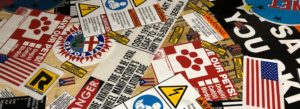Warehouse tags are used in organizations across the nation to properly identify and track their assets and inventory. In addition, warehouse nameplates provide long-lasting identification and labeling.
What are Warehouse Tags Used For?
Inventory Management
The most common use for warehouse tag is inventory management. Logistics and managing supply chains can be difficult business. The more quality information decision makers have access to, the easier their choices will be.
These applications typically utilize bar code inventory tags for the ability to scan information. This makes managing inventory significantly easier.
By incorporating a barcode scanning system, your warehouse or distribution center will see massive improvements in efficiency.
Plus you’ll have the information about why issues occur and will be able to tackle them.
Asset Tracking
Another common use for metal tags in the world of warehouses is asset tracking. Assets are an incredibly important resource for any organization, and getting the best utilization out of them is important.
Traceable assets include:
- Equipment
- Machinery
- Tools
- And More!
Asset tracking not only helps accomplish this, but also aids in preventing theft or other potential issues. Equipment, machinery, and more.
Labeling/Identification
Of course, metal nameplates aren’t solely for scanning and tracking. They are also heavily relied upon for consistent and reliable identification throughout a warehouse.
Every rack, pallet, and machine should be accurately labeled.
In addition, warning labels and signs are incredibly important to maintaining a safe warehouse. Many OSHA guidelines require proper labeling.
Barcodes
In order to use barcode tags, your organization needs to be outfitted with barcode scanners as well as software to handle the information. This will allow for the reading and writing of information to the tags.
There are several types of barcodes as well. Traditional UPC barcodes are often used for inventory management. QR codes provide a compact square code which can house various data as well. The choice is up to the end user which best fits their application.

Processes
MetalPhoto
MetalPhoto is a special-made anodized aluminum. It uses a unique process to embed a design underneath protective layers of metal.
Since the material is highly durable it is used in countless industrial applications. Everyone from oil refineries to the military rely on this process to create a lasting custom identification solution.

Photo anodization can add any image, design, characters, or numbers to your tag or nameplate. Whether it’s a logo, a unique design, or just basic numbering; MetalPhoto can do it all.
In addition, a solid color can be added to the nameplates to give them a stand out appearance or for color coding purposes.
For warehouses, barcodes are a must. The MetalPhoto process can add any kind of barcode your warehouse uses. This includes QR codes, Data Matrix, 2D UPC codes, and more.
Decals
If metal tags just won’t work for your application, decals are another viable solution. They provide the same level of customization as photo anodization with a few extra benefits. Since decals are printed, they can include full color designs.
The drawback to decals is that they are not as durable. The printed ink is fully susceptible to wear and tear, especially in industrial conditions.

They will not survive being exposed to the elements. Water, spills, chemicals, and weather will deteriorate the labels very quickly.
In addition, the material is a vinyl or plastic as opposed to solid metal. After a year in a busy warehouse your decal may be in rough conditions.
Decals can be laminated to provide additional protection, but are still susceptible to damage in tough environments.
Wrap-Up
If your warehouse isn’t implementing barcode tracking, you’re already behind the curve. Get your organization up to speed to ensure you aren’t wasting time and money on inefficient processes.
At the bare minimum, your warehouse should be up to date with clear and easy to read identification labeling.
With these additions operations become easier, processes become quicker, and overall efficiency is improved.